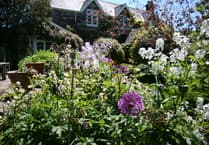THE long and varied history of Horrabridge will be on show in St John's Church in the village over three days in early July. The exhibition is based largely on photographs, maps and plans collected from various sources by Jill and Jinks Fitzsimmons over the last 25 years. The bridge itself was built originally in 1260, at the site of an ancient crossing on the river Walkham where three parish boundaries meet. This gave the village its name, as 'horra' was the ancient word for a boundary. Horrabridge grew around the river and the old road system, and its expansion, gradual over hundreds of years, really accelerated in the latter part of the 19th century with the development of local industries – mining, textiles, flour mills, brickworks and agriculture. Horrabridge became a thriving working village, with the mines producing copper, tin, arsenic and pyrites — sulphides from which minerals can be extracted — for industrial applications. The influx of workers led to the opening of shops to serve growing numbers of residents, and a number of public houses to enable the workers to slake their thirst. Many of the plans and maps on display give an idea of the scale of industry as it was in the village a century ago, and the photographs from the last 100 years show how much Horrabridge has changed in the intervening years. The exhibition will be open from 6pm to 9pm on Friday, July 11, from 10am to 6pm on Saturday, July 12, and from noon to 5pm on Sunday, July 13. Admission is £2 per adult, with no charge for children under 16 years, and refreshments will be available with all proceeds going to the Friends of St John's Church. l A view of Horrabridge is pictured above.



.jpeg?width=209&height=140&crop=209:145,smart&quality=75)
-with-lightning).jpeg?width=209&height=140&crop=209:145,smart&quality=75)
Comments
This article has no comments yet. Be the first to leave a comment.